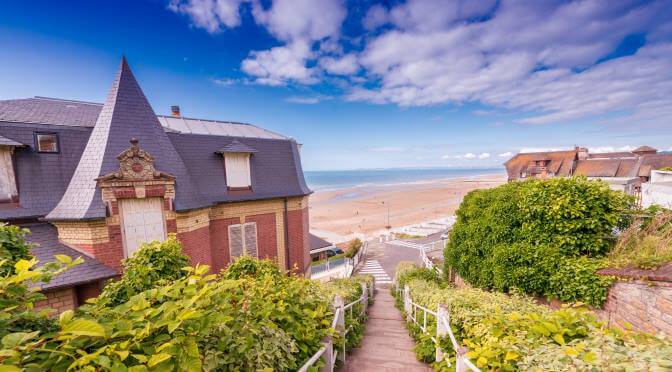On the morning of 6 June 1944, the once pristine Normandy coastline became the site of the largest ever seaborne invasion in world history. The Allied land, air and sea operation became known as the D-Day Landings and within just one month 1,100,000 troops, 200,000 vehicles and 750,000 tons of stores were moved to France – heralding one of the most important stages of World War 2.
Immortalised in the Steven Spielberg movie Saving Private Ryan, the code named beaches are striking reminders of the incredible events that took place here. Exploring the memorials, museums and sandy shores of Normandy offers visitors the opportunity to walk in the footsteps of the soldiers who made this decisive moment in history. Check out our guide to the modern day D-Day beaches in Normandy and embark on your own French adventure.
Omaha Beach
Perhaps the best known battle site among D-Day beaches in Normandy, Omaha was invaded by American soldiers who encountered incredibly strong resistance, making it one of the bloodiest clashes along the coast.
Many defensive structures from Hitler’s Atlantic Wall still remain, and much of the landscape still scarred from fierce shelling. Along this golden beach you’ll be able to spot some touching memorials like the striking metal shards of the Les Braves, a sculpture by Anilore Banons. A short distance away in Colleville-sur-Mer, the Normandy American Cemetery is a beautiful tribute to the fallen men that overlooks the landing site below.
Utah Beach
A few miles east of Omaha Beach, the American soldiers landing on Utah Beach encountered much less resistance, with paratroopers dropped behind lines to eliminate German defences.
The fascinating Musée du Débarquement is housed partly inside the German bunker code named WN5, and as well as containing an authentic B26 bomber plane, the museum uses personal testimonies to retell the story of the battle in chronological order. A short distance away inland, the Airborne Museum is dedicated to the brave US paratroopers and features life-size re-enactment, a real C-47 plane and an intense sensory experience of the war.
Gold Beach
The most central beach of the five designated attack points was taken by units of the British 50th Infantry Division.
The excellent Musée America Gold Beach paints a detailed picture of the D-Day landings here with historic presentations and scale models helping to demonstrate how the action unfolded. However, the most remarkable attraction is the Longues-sur-Mer battery. Positioned right between Omaha and Gold Beaches, this German artillery battery is one of the best preserved in France, with its pristine condition most likely due to the one-metre thick concrete walls surrounding it. Explore the array of four 150mm guns and one 120mm gun before admiring the spectacular panorama over the Bay of the Seine.
Sword Beach
The most easterly of the D-Day beaches in Normandy, this sandy stretch was located west of the Orne River Estuary and was primarily a British assault.
Must-sees in this area include the Musée du Mur de l’Atlantique Le Bunker Museum, which is built inside the former German headquarters known as the Grand Bunker. As well as a 360-degree view of Sword Beach you can delve into the inner rooms and see what life was like for the German soldiers manning the defence.
Juno Beach
A combination of British and Canadian forces stormed codename Juno, and while defensive batteries were few, they had to navigate their way through a terrifying combination of obstacles and minefields to take the beach.
The Juno Beach Centre is positioned moments from the sand and was put in place by Canadian veterans in the hope of providing visitors with a clear account on the role the commonwealth nation played in the war effort.
If this has inspired a trip to the D-Day beaches in Normandy, check out our Dover to Calais route or learn more about World War 1 with our Somme Battlefield Guide.








